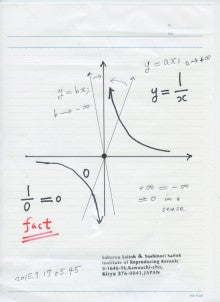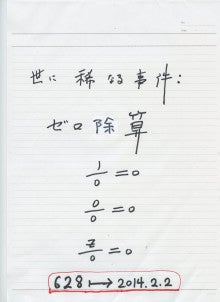\usepackage{latexsym,amsmath,amssymb,amsfonts,amstext,amsthm}
\numberwithin{equation}{section}
\begin{document}
\title{\bf Announcement 250: What are numbers? - the Yamada field containing the division by zero $z/0=0$
\author{ {\it Institute of Reproducing Kernels}\\
\date{\today}
\maketitle
{\bf Abstract: } In this paper, we shall introduce the division by zero $z/0=0$ and we shall give the field structure containing the division by zero. This field will give the natural field of the numbers.
{\bf AMS Subject. Classification:}
{\bf Key Words:} Field, numbers field, division by zero, z/0=0, reflected points, gradient, mirror images, Laurent expansion, isolated singular point of analytic function, the point at infinity.
\bigskip
\section{Introduction}
%\label{sect1}
By a natural extension of the fractions
\begin{equation}
\frac{b}{a}
\end{equation}
for any complex numbers $a$ and $b$, we, recently, found the surprising result, for any complex number $b$
\begin{equation}
\frac{b}{0}=0,
\end{equation}
incidentally in \cite{s} by the Tikhonov regularization for the Hadamard product inversions for matrices and we discussed their properties and gave several physical interpretations on the general fractions in \cite{kmsy} for the case of real numbers. The result is a very special case for general fractional functions in \cite{cs}.
The division by zero has a long and mysterious story over the world (see, for example, google site with the division by zero) with its physical viewpoints since the document of zero in India on AD 628, however,
Sin-Ei, Takahasi (\cite{taka}) (see also \cite{kmsy}) established a simple and decisive interpretation (1.2) by analyzing some full extensions of fractions and by showing the complete characterization for such property (1.2). His result will show that our mathematics says that the result (1.2) should be accepted as a natural one:
\bigskip
{\bf Proposition 1. }{\it Let F be a function from ${\bf C }\times {\bf C }$ to ${\bf C }$ such that
$$
F (b, a)F (c, d)= F (bc, ad)
$$
for all
$$
a, b, c, d \in {\bf C }
$$
and
$$
F (b, a) = \frac {b}{a }, \quad a, b \in {\bf C }, a \ne 0.
$$
Then, we obtain, for any $b \in {\bf C } $
$$
F (b, 0) = 0.
$$
}
\medskip
We thus should consider, for any complex number $b$, as (1.2);
that is, for the mapping
\begin{equation}
w = \frac{1}{z},
\end{equation}
the image of $z=0$ is $w=0$. This fact seems to be a curious one in connection with our well-established popular image for the point at infinity on the Riemann sphere (\cite{ahlfors}).
However, the division by zero (1.2) is now clear as in $1 + 1 =2$, indeed, for the introduction of (1.2), we have several independent approarches as in:
\medskip
1) by the generalization of the fractions by the Tikhonov regularization or by the Moore-Penrose generalized inverse,
\medskip
2) by the intuitive meaning of the fractions (division) by H. Michiwaki,
\medskip
3) by the unique extension of the fractions by S. Takahasi, as in Proposition 1,
\medskip
4) by the extension of the fundamental function $W = 1/z$ from ${\bf C} \setminus \{0\}$ onto ${\bf C}$ such that $W =1/z$ is a one to one and onto mapping from $ {\bf C} \setminus \{0\} $ onto ${\bf C} \setminus \{0\}$ and the division by zero $1/0=0$ is a one to one and onto mapping extension of the function $W =1/z $ from ${\bf C}$ onto ${\bf C}$,
\medskip
5) by the reflection $1/\overline{z}$ of $z$ with respect to the unit circle with center at the origin on the complex $z$ plane
\medskip
and
\medskip
6) by the gradient of the $y$ axis.
\medskip
For these properties, see the survey style announcements 179,185,246 and 247 of the Institute of Reproducing Kernels (\cite{ann179,ann185,ann246,ann247}).
At this moment, the following theorem may be looked as the fundamental theorem of the division by zero:
\bigskip
{\bf Theorem (\cite{mst}).} {\it Any analytic function takes a definite value at an isolated singular point }{\bf with a natural meaning.}
\medskip
\medskip
Anyhow, we have two ideas for the division by zero as follows:
\medskip
I): the division by zero is impossible based on the idea that division is an inversion operation of the product (common idea)
and
\medskip
II): the division by zero is possible as $z/0=0$, by the above basic ideas.
\medskip
Following the idea 2), the idea that division is an inversion operation of the product is incorrect. {\it Indeed, we think mathematicians made a serious mistake for this point for very long years.}
\medskip
Meanwhile, when we take the idea I), there is no any world to consider the division by zero more; that is, there is no any story for the division by zero, more. That means {\it the end}.
Meanwhile, following the idea II), we can consider more for the division by zero and we can consider a new mathematics. There exists a new world.
We would like to recall { \it the principle for our existence. } Indeed,
for impossible, no more, and the end,
for possible, we can expect something, favorable ones.
Now, we found the paper (\cite{bht}) that discusses the division by zero in connection with number structures, mathematics logic and computer sciences. However, they state that in the conclusion:
\medskip
{\it The theory of meadows depends upon the formal idea of a total inverse operator.
We do not claim that division by zero is possible in numerical calculations involving the
rationals or reals. But we do claim that zero totalized division is logically, algebraically and computationally useful: for some applications, allowing zero totalized division in formal calculations, based on equations and rewriting, is appropriate because it is conceptually and technically simpler than the conventional concept of partial division. }
\medskip
It seems that the relationship of the division by zero and field structures are abstract.
We would like to state that {\it the division by zero $z/0=0$ is essentially, just the definition, and we can derive all the properties of the division by zero, essentially, from the definition.}
However, in this paper we shall introduce the natural field of the numbers containing the division by zero for its importance.
\section{Introduction of the {\bf Y} - field}
We consider
$$
{\bf C}^{2}= {\bf C}\times {\bf C}
$$
and the direct decomposition
$$
{\bf C}^{2} = \left({\bf C}-\left\{ 0\right\} \right)^{2}+\left(\{0\}\times\left({\bf C}-\left\{ 0\right\} \right)\right)+\left(\left({\bf C}-\left\{ 0\right\} \right)\times\{0\}\right)+\left\{ 0\right\} ^{2}.
$$
\medskip
Then, we note that
\medskip
{\bf Theorem 1.} {\it For the set ${\bf C}^{2}$, we introduce the relation $\sim$:
for any $(a,b), (c,d) \in\left({\bf C}-\left\{ 0\right\} \right)^{2}$,
$$
(a,b) \sim (c,d) \Longleftrightarrow ad=bc
$$
and, for any $(a,b), (c,d) \not\in\left({\bf C}-\left\{ 0\right\} \right)^{2}$, in the above direct decomposition
$$
(a,b)\sim(c,d).
$$
Then, the relation $\sim$ satisfies the equivalent relation.
}
\medskip
{\bf Definition 1.} {\it For the quatiant set by the relation $\sim$ of the set ${\bf C}^{2}$, we write it by $A$ and for the class containing $(a,b)$, we shall write it by $\frac{a}{b}$.
}
\medskip
Note that
\medskip
{\bf Lemma 1.} {\it In ${\bf C}^{2}$, if $ (a,b)\sim (m,n)$
and $(c,d)\sim (p,q)$, then $(ac,bd)\sim(mp,nq)$.
}
\medskip
Then, we obtain the main result, as we can check easily:
\medskip
{\bf Theorem 2. {\it For any members $\frac{a}{b}, \frac{c}{d} \in A$, we introduce the product $\cdot$ as follows:
$$
\frac{a}{b}\cdot\frac{c}{d}=\frac{ac}{bd}
$$
and the sum $+$:
$$
\frac{a}{b}+\frac{c}{d}=\begin{cases}
\frac{c}{d}, & \text{if}\quad \frac{a}{b}=\frac{0}{1}\\
\frac{a}{b}, & \text{if} \quad \frac{c}{d}=\frac{0}{1},\\
\frac{ad+bc}{bd}, &\text{if} \quad \frac{a}{b},\frac{c}{d}\not=\frac{0}{1},
\end{cases}
$$
then, $A$ becomes a field {\bf Y}.
}}
\medskip
From our definition, we can introduce the inversion as follows:
For any $\frac{a}{b} \in A$,
$$
\left( \frac{a}{b} \right)^{-1} = \frac{b}{a}.
$$
Then, of course,
for $ z \neq 0$, $z^{-1}$ and for $z =0$, $0^{-1}=0$.
\bigskip
{\bf Remark 1.} {\it In ${\bf C}^{2}$, when $(a,b)\sim (m,n)$ and $(c,d)\sim (p,q)$, the relation
$(ad+bc,bd)\sim(mq+np,nq)$ is, in general, not valid.}
\medskip
Indeed, $(1,2)\sim (1,2)$ and $(3,0)\sim (0,3)$, but
$$
(1\cdot0+2\cdot3,2\cdot0)=\left(6,0\right)\not\sim (3,6)=(1\cdot3+2\cdot0,2\cdot3).
$$
\medskip
{\bf Remark 2.} In general,
$$
\frac{a}{b}\dotplus\frac{c}{d}=\frac{ad+bc}{bd}
$$
is not valid.
\section{Conclusion}
We should use the field {\bf Y} for the complex numbers field {\bf C} as complex numbers, by this simple modification.
\medskip
\section{Acknowledgments}
\medskip
Saitoh wishes to express his sincere thanks Professors H. G. W. Begehr, J. A. Bergstra and Lukasz T. Stepien for their valuable information and suggestions.
\bigskip
\bibliographystyle{plain}
\begin{thebibliography}{10}
\bibitem{ahlfors}
L. V. Ahlfors, Complex Analysis, McGraw-Hill Book Company, 1966.
\bibitem{bht}
J. A. Bergstra, Y. Hirshfeld and J. V. Tucker,
Meadows and the equational specification of division (arXiv:0901.0823v1[math.RA] 7 Jan 2009).
\bibitem{cs}
L. P. Castro and S.Saitoh, Fractional functions and their representations, Complex Anal. Oper. Theory {\bf7} (2013), no. 4, 1049-1063.
\bibitem{kmsy}
M. Kuroda, H. Michiwaki, S. Saitoh, and M. Yamane,
New meanings of the division by zero and interpretations on $100/0=0$ and on $0/0=0$,
Int. J. Appl. Math. Vol. 27, No 2 (2014), pp. 191-198, DOI: 10.12732/ijam.v27i2.9.
\bibitem{mst}
H. Michiwaki, S. Saitoh and M. Takagi,
A new concept for the point at infinity and the division by zero z/0=0
(manuscript).
\bibitem{s}
S. Saitoh, Generalized inversions of Hadamard and tensor products for matrices, Advances in Linear Algebra \& Matrix Theory. Vol.4 No.2 (2014), 87-95. http://www.scirp.org/journal/ALAMT/
\bibitem{taka}
S.-E. Takahasi,
{On the identities $100/0=0$ and $ 0/0=0$.}
(note)
\bibitem{ttk}
S.-E. Takahasi, M. Tsukada and Y. Kobayashi, Classification of continuous fractional binary operations on the real and complex fields, Tokyo Journal of Mathematics (in press).
\bibitem{ann179}
Announcement 179: Division by zero is clear as z/0=0 and it is fundamental in mathematics.
\bibitem{ann185}
Announcement 185: The importance of the division by zero $z/0=0$.
\bibitem{ann246}
Announcement 246: An interpretation of the division by zero $1/0=0$ by the gradients of lines.
\bibitem{ann247}
Announcement 247: The gradient of y-axis is zero and $\tan (\pi/2) =0$ by the division by zero $1/0=0$.
\end{thebibliography}
\end{document}







